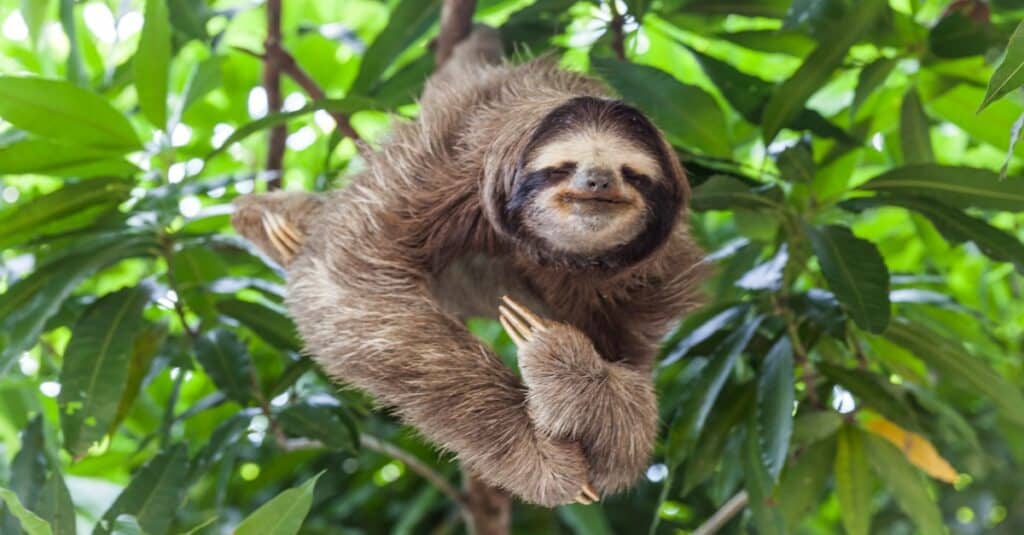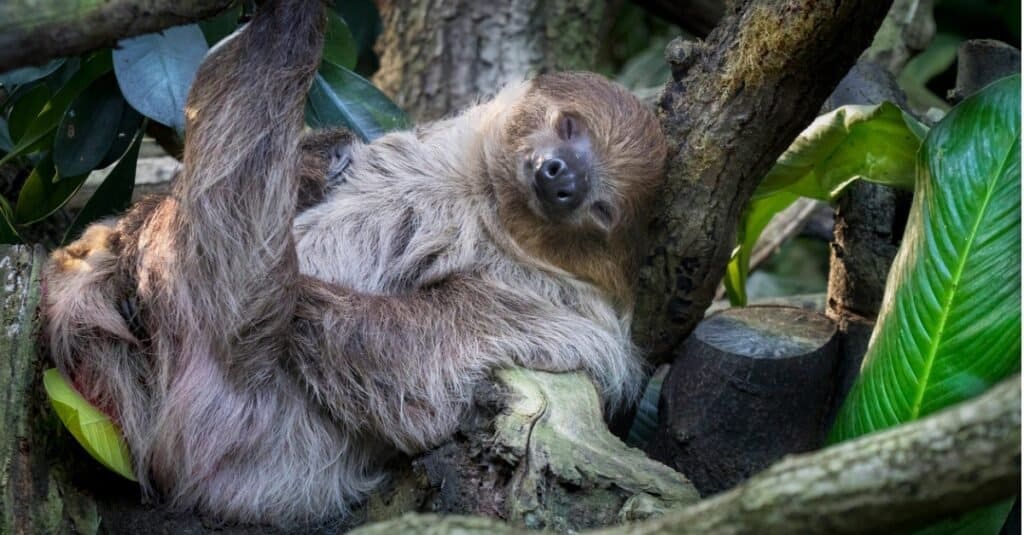Quick Answer:
- No, sloths are not dangerous if they are left alone in their natural environment.
- They pose no threat to humans unless they feel threatened.
- If they grow agitated, they can bite a human with their sharp teeth or slash with their long nails. Their bites are deep and can get infected quickly.
Even though they appear cute and cuddly, a sloth has teeth and strong claw-like nails that serve as a constant reminder of the damage they can cause. The average sloth can grow to a height of 2.5 feet and weigh anywhere from nine to 17 pounds. Yet, despite their small stature and slow nature, sloths can inflict significant injury if provoked. Find out how dangerous sloths can be.
Are Sloths Dangerous?

When left alone, sloths are not dangerous by any means, but when threatened, they can inflict pain.
©iStock.com/Parkol
If sloths are left alone in their natural environment, they pose no threat to humans. If they feel threatened, they can use their long nails or teeth to inflict pain. When sloths grow agitated, they could potentially attack anyone who tries to interact with them, whether another sloth, a predator, or even a friendly human. Sloth bites are deep, nasty, and can get infected quickly.
Diseases that can be transferred to humans are found in most sloths. Insects that can transmit diseases to people, such as mosquitos, are carried in their fur.
Is It Dangerous to Touch a Sloth?

It is best not to handle or touch a sloth as they are highly sensitive creatures.
©Janossy Gergely/Shutterstock.com
Sloths are extremely sensitive creatures. Because sloths are highly scented animals, touching them can be dangerous. They can be agitated by perfumed lotions, loud noises, or inappropriate handling.
Do Sloths Have Claws or Nails?

Sloths have strong, long nails they use to grip and hang from trees.
©iStock.com/Nachosuch
To help them grip onto trees, sloths have lengthy nails that resemble claws. They enjoy hanging upside down, and their nails readily wrap around the branches when they do. Sloths have coarse brown fur, lengthy limbs, and curled claws for clinging to tree branches. They have adapted to living upside down.
Do Sloths Have Teeth?

Though sloths lack incisor canine teeth, they have two pairs of prominent razor-sharp fangs.
©milan noga/Shutterstock.com
They don’t have deciduous teeth; instead, they have a single set of high-crowned, open-rooted teeth that develop constantly throughout their lives. Sloths only have 10 upper and eight lower teeth. A sloth’s two front teeth, which they use to bite off their meal, are the most visible. Their other teeth are flat, and they utilize them to grind their meal of tree leaves.
Because they are the world’s slowest animals and cannot easily flee a predator, they fight with their keen teeth and nails. Sloths, unlike most animals, lack a protective layer of enamel on their teeth, making tannins more easily absorbed. Tannins are biomolecules that are responsible for the brown color of dead leaves. A sloth’s fangs can turn black due to the substantial number of tannins in its mouth.
Are Sloths Aggressive?

Two-toed sloths are known to be more aggressive than three-toed sloths.
©Sylvia Westenbroek / Flickr – Original
Two-toed sloths are known to be aggressive and capable of causing severe damage with their nails. These sloths have two toes on their forelimbs, while three-toed sloths have three. Three-toed sloths have more vertebrae than two-toed sloths and are a little more laid-back, but they still don’t like it when humans touch them. They have various families and species counts.
Are Sloths Friendly?

Sloths are anti-social creatures who are happiest on their own.
©Julia Kerschbaum / Creative Commons – Original
While sloths are known for their chill personalities, they are not social animals. They live alone in the wild and try not to attract the attention of other animals as a means to avoid predators. Because sloths are solitary, they aren’t used to being touched and can find even light petting threatening.
Can A Sloth Be a House Pet?

Due to their solitary and wild nature, sloths do not make good pets.
©Ontley, CC BY-SA 3.0, via Wikimedia Commons – Original / License
Domesticated sloths can live longer than wild sloths, although they can be expensive and require specific training and/or licenses in some locations. The disadvantages of having a pet sloth are large enough to dissuade most people. In the wild, two-toed sloths can live up to 20 years.
How Fast Does a Sloth Move?

At its fastest, the sloth moves a mere 0.17mph!
A sloth’s maximum speed, when threatened, is only 0.17 mph. To put this into perspective, crawling a mile would take them more than nine and a half hours. However, it would take several days to manage this, as they can only cover about 120 feet in a day on average. Interestingly, they can swim three times as fast as they can walk.
The sloth moves slowly on the ground, dragging itself along by its claws at a snail’s speed of 15 yards per minute. Unfortunately, they can be easily attacked.
What Do Sloths Eat?

Sloths eat leaves, flowers, and tree twigs.
©Damsea/Shutterstock.com
Sloths eat leaves, twigs, and flower buds. Because they lack incisors, the animals grip with their strong lips, baring down on leaves. It takes them days to digest what other animals may digest in a couple of hours. Sloths have a slow metabolic rate so they can survive on little food.
The photo featured at the top of this post is © jdross75/Shutterstock.com
FAQs (Frequently Asked Questions)
Why Do Sloths Hang Upside Down?
To get to tender fresh leaves that sprout on the end of branches, a sloth must hang upside down. Newer leaves have fewer toxins and are therefore easier for the sloth to consume. They even sleep upside down because of their unusual, hooked claws. You’d be hard-pressed to discover a sloth sleeping on the ground because they’re significantly more vulnerable to predators when they’re spotted.
Thank you for reading! Have some feedback for us? Contact the AZ Animals editorial team.







